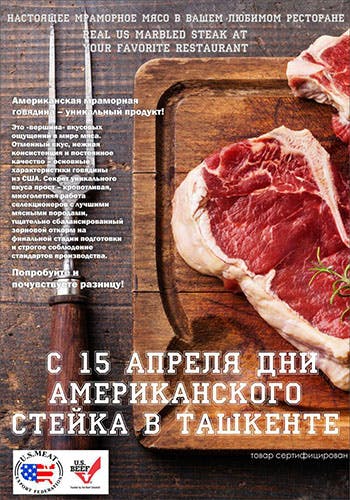U.S. Beef, Pork Highlighted at WorldFood Uzbekistan

Visitors to the USMEF booth during WorldFood Uzbekistan were provided with educational materials on U.S. beef and pork
Meeting with traders and meat processing companies at WorldFood Uzbekistan 2016 allowed USMEF to gain further insight into this emerging market while also laying the groundwork for the upcoming “Days of U.S. Steak” event aimed at Uzbekistan’s HRI sector. Participation in WorldFood Uzbekistan was supported by the USDA Market Access Program (MAP), the Beef Checkoff Program and the Pork Checkoff.
A country of 30 million people with a diverse and fast-growing economy, Uzbekistan has few restrictions on imports of U.S. beef products, but does not allow U.S. pork imports due to porcine epidemic diarrhea virus (PEDV) concerns.
USMEF’s presence at WorldFood Uzbekistan was part of a continuing effort to re-inforce the quality and safety of U.S. red meat.
“The Uzbekistan market can offer good returns to those able to break into it,” said Yuri Barutkin, USMEF representative in Russia and the Surrounding Region. “We felt that, despite lack of access for U.S. pork, it was still important to be at the show and continue to indicate our interest in the market.” Held in Tashkent, Uzbekistan’s capital city, the 2016 show attracted more than 160 companies from 28 countries. The strong belief that Uzbekistan’s domestic meat production is not keeping pace with its growing demand drew exporters from around the world.

This poster distributed during WorldFood Uzbekistan promotes the upcoming U.S. beef promotion “Days of U.S. Steak”
“Beef is produced locally in large quantities but most of it is from small backyard farms, thus not offering the country’s meat processors a stable supply,” Barutkin explained. “The EU, Brazil and India have covered the gaps in local production. While we realize that Uzbekistan market is far from mature and that there is still a lot of work that needs to be done to establish a solid U.S. beef and pork presence, we think the market’s potential is definitely worth the effort.”
USMEF also used WorldFood Uzbekistan as a platform to promote U.S. beef offals.
“Consumers in Uzbekistan are familiar with beef livers and other beef offals but they do not consume them on a regular basis because there is no stable and safe supply,” said Barutkin. “At the show this year, we pointed out that U.S. beef livers and other beef offal products offer high quality at very competitive prices.”
Also on the beef side, USMEF was able to spread the word about “Days of U.S. Steak” – an event that will promote U.S. beef steaks in some leading Tashkent restaurants.
Meanwhile, with virtually no commercial pork production in Uzbekistan, the demand for pork is satisfied by imports from the European Union. USMEF continues to promote U.S. pork through educational efforts. Last April, USMEF arranged for a team of veterinary officials from Uzbekistan to visit the U.S. for a tour of the U.S. pork supply chain. The group attended meetings in Washington, D.C., where the regulatory responsibilities of various USDA agencies were explained. Meetings were held with the National Pork Board and the Uzbekistan vets toured the Iowa State University Diagnostic Laboratory in Ames, Iowa, and the Tyson Foods pork plant in Storm Lake, Iowa.
Barutkin said the approach at the USMEF booth at WorldFood Uzbekistan 2016 was to keep U.S. pork on the minds of importers.
“Uzbekistan is a market with strong chicken, beef and lamb consumption – and one with a well-developed meat processing sector,” said Barutkin. “Although a large portion of the population are non-denominational Muslims, there are still many people who consume fresh pork and processed pork products on a regular basis.”
